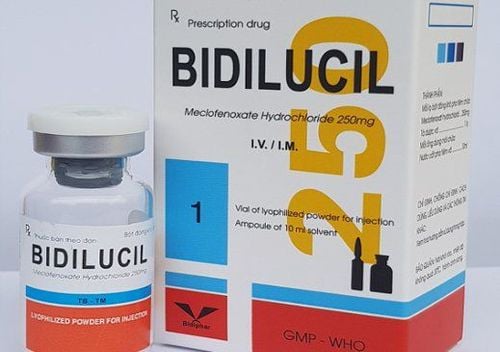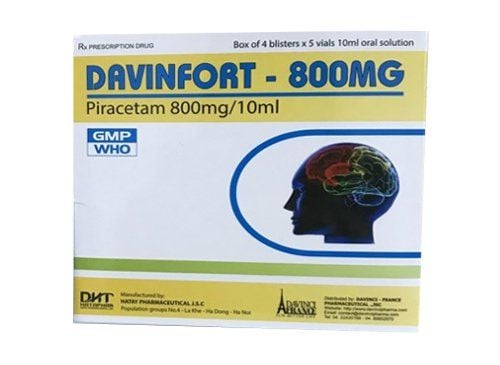This is an automatically translated article.
Nasahep drug is a drug to treat dizziness, memory loss, poor concentration, lack of alertness in the elderly. However, Nasahep does not have the effect of sedation, pain relief, sleep, resuscitation, ... Nasahep is prepared in the form of hard capsules with the main ingredient of the drug is Piracetam.
1. What is Nasahep?
Nasahep drug is a drug to treat dizziness, memory impairment, poor concentration, lack of alertness in the elderly, alcoholic subjects or patients with sickle cell disease. Nasahep is available in the form of hard capsules.
Nasahep medicine has the main ingredient Piracetam (content 400mg) with a shelf life of 36 months from the date of manufacture. Nasahep is packaged in a box of 1 blister, each blister contains 10 capsules.
2. What effect does Nasahep have after use?
Piracetam ingredient in Nasahep is a substance capable of causing mania. This chemical can act on acetylcholine, dopamine, noradrenalin,... (these are neurotransmitters). Therefore, Nasahep drug can change neurotransmitters, thereby improving metabolism so that nerve cells work better. Based on several studies, by virtue of its ability to increase the brain's resistance to hypoxia, piracetam may provide cerebral tonic protection against ischemic metabolism.
The drug does not have the effect of sedation, sleep, pain relief, resuscitation,... In addition, Nasahep also works to reduce platelet aggregation. In cases of hard or irregularly shaped red blood cells, Nasahep can help red blood cells regain their shape and ability when passing through the capillaries, drugs can be used to prevent muscle convulsions.
Nasahep is rapidly absorbed after oral administration (almost completely absorbed from the gastrointestinal tract). Absorption of the drug will not change with treatment for a long time. Piracetam can penetrate all tissues, blood vessels, blood-brain barrier, placenta and even membranes used in renal dialysis.
3. Subjects assigned to use Nasahep
Patients with vertigo The elderly have manifestations of dizziness, memory impairment, lack of alertness, poor concentration, behavioral disturbances, mood changes, poor attention to themselves, depression intellectual (caused by cerebral infarction) Patients with acute ischemic stroke (studied in a clinical trial). However, when using Nasahep for subjects with complications, attention should be paid to the age and severity of the disease. This is an important factor affecting patient survival after acute ischemic stroke. People with symptoms of alcoholism In addition, Nasahep is also used to support dyslexia in children, to support the treatment of myoclonic tremor (caused in the cerebral cortex), sickle cell disease.
4. Instructions for using Nasahep and drug dosage
Nasahep is made in hard capsule form, so patients should take it orally with a full glass of water. Before using the drug, you should carefully read the accompanying instructions for use or follow the instructions of your doctor.
Dosage of Nasahep medicine according to usual indications:
Adults should take 1 to 2 tablets, 3 times a day Children should take 1 tablet, 2 times a day For patients with kidney failure (Level range from mild to moderate) need to reduce dose or increase dose gradually at intervals
5. Contraindications to the use of Nasahep
People with hypersensitivity to any ingredient in the drug (Piracetam)
Patients with severe renal failure with creatinine clearance less than 20 ml/min absolutely do not use the drug
Patients with disease liver failure or huntington.
6. Things to pay attention to during the use of Nasahep
For patients with kidney failure, the distance between things needs to be far apart. If the renal creatinine clearance is less than 60 ml/min, the dose should be reduced. This is because most of piracetam is eliminated by the kidneys.
In elderly patients with renal failure, if using the drug, renal function should be monitored regularly. Dosage adjustment decisions are made based on creatinine clearance:
Serum creatinine between 1.25 and 1.7 mg/100mi and a creatinine clearance of 60 -40 mL/min: Patients should reduce their dose, only Take 1/2 the amount of the drug compared to the normal dose. Serum creatinine is 1.7 to 3.0 mg/100 mi, creatinine clearance is 40 - 20ml/min: Only one-quarter of the drug is used compared to the normal dose. Nasahep can cross the placenta and is excreted in breast milk, so Nasahep is not indicated for women who are pregnant or breastfeeding.
When using Nasahep, you may experience some unwanted side effects such as: General fatigue, agitation, drowsiness, headache, restlessness, digestive disorders, vomiting, nausea, diarrhea, abdominal distension, abdominal pain. Less common symptoms that Nasahep can cause: Whole body dizziness, sexual arousal, sexual tremor,... When the patient has one of the above symptoms, it is necessary to immediately notify the treating doctor to there is a decision to reduce the dose or replace it with another drug with the same effect.
Nasahep can cause dizziness and drowsiness, so patients should not do tasks that require high concentration after taking the drug.
Nasahep is a medicine to treat dizziness, memory impairment, poor concentration, lack of alertness in the elderly, alcoholic subjects or patients with sickle cell disease. With its effective and easy to use effect, Nasahep is trusted by many patients. However, like other drugs, Nasahep can cause some unwanted side effects during use. Therefore, before using any medicine, you should consult your doctor to avoid the worst case scenario.













